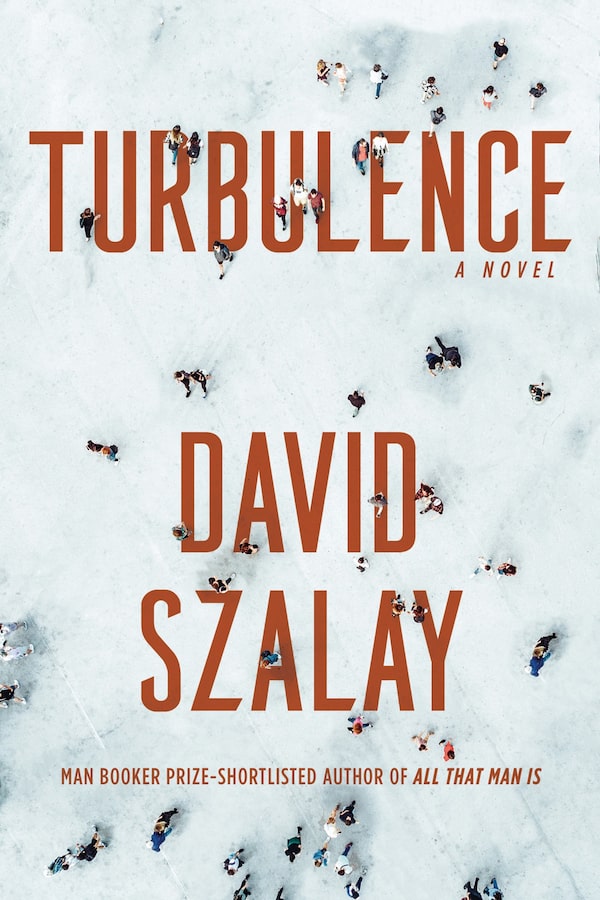
Turbulence by David Szalay.Supplied
- Title: Turbulence
- Author: David Szalay
- Genre: Fiction
- Publisher: McClelland & Stewart
- Pages: 144
A character in David Szalay’s new book has a quote by John F. Kennedy on his wall that is also a clear signalling toward the guiding principle behind these daisy-chained stories: “For, in the final analysis, our most basic common link is that we all inhabit this small planet. We all breathe the same air. We all cherish our children’s futures. And we are all mortal.”
In Turbulence, much of that common air is breathed in the cabins of various aircraft, modern air travel functioning here as humanity’s great unifier. (Though if you’ve ever stood barefoot as a security agent riffles through your undergarments in full view of impatient fellow travellers, “unity” likely won’t be the first word that pops to mind.)
It’s a slim book that feels, in many ways, as a scaled-down version of its Man Booker-nominated predecessor, All That Man Is. Each brief tale involves a flight, with chapters named for the airport codes of these journeys, “GRU–YYZ” etc. We begin in London, at the apartment of a cancer-stricken man, touching down in Sao Paolo, Dakar, Hong Kong, Delhi and Budapest (where Montreal-born, England-raised Szalay currently lives), among other places, before returning to the same London apartment. A minor character in one story comes to the fore in the next, and so forth, which gives the novel a wavelike feel. That there are 12 stories in all seems uncoincidental, 12 being a number often associated with perfection in cosmology and various religions.
Despite the handy concept, the unshowy ease of his prose, however, Szalay’s command of detail often seems less than perfect. This starts with the opening story, in which an elderly woman en route to Madrid after visiting her son (the aforesaid cancer-stricken man) falls ill after enduring some extreme turbulence (and a series of Bloody Marys). Before that, she’d been irritated and perplexed by the foreign-looking man next to her, who took the middle seat even though the aisle was free. We share her confusion – what kind of perversity is that? But although the next story, set in Dakar, recounts the incident from the man’s perspective, the waters only become more brackish. It turns out the man is extremely wealthy. Would someone who lives in a gated mansion and has a personal driver (whose children’s tuition he pays for), really be slumming it in the middle seat, let alone flying economy?
A story set in Toronto raises other questions. Marianne Mackenzie, a famous Canadian novelist, is being interviewed in her condo by a journalist who’s flown all the way from Brazil for the occasion (perhaps arts journalism in Brazil is well-funded, but even so, why not Skype?). The interview is briefly interrupted by a phone call. Marianne takes it, then regretfully tells the journalist she has to cut things short: Her daughter, Wendy, has just gone into labour in Seattle and the only flight leaves in two hours. Does she know the flight schedules by heart? And if she was planning to be there for the birth (not Wendy’s first) – which doesn’t seem to be premature – mightn’t she have booked in advance?
Later, more perplexity: Marianne doesn’t like children. Nor does she seem to have a close, or at least easy, relationship with her daughter, who furiously tells her when she arrives at the hospital that the doctors think her newborn is blind. Marianne makes her living with words, but now she’s at such a complete loss for them that she simply changes the subject. In the next story, she goes to Hong Kong for a tryst with her doctor and flies, as wealthy Canadian authors do … first-class. Or at least a class that provides beds.
Later, in Delhi, a man named Abir enters his dying father’s house and sees “what appeared to be school photos” on the wall. That phraseology wouldn’t be odd but for the fact that Abir knows they’re school photos: This is the house he grew up in and the photos are of his own school, where his father was headmaster.
These bits of narrative illogic might be more easily ignored in writing less strenuously transparent, or as rooted in the everyday (the stories were originally written for radio, which might be a factor). Or even in a longer book – but at 135 pages of text, Turbulence qualifies as that gangly adolescent of literature, the novella and unfortunately its acne scars are all too apparent.
Emily Donaldson is the editor of Canadian Notes & Queries and Best Canadian Essays 2019.
Expand your mind and build your reading list with the Books newsletter. Sign up today.